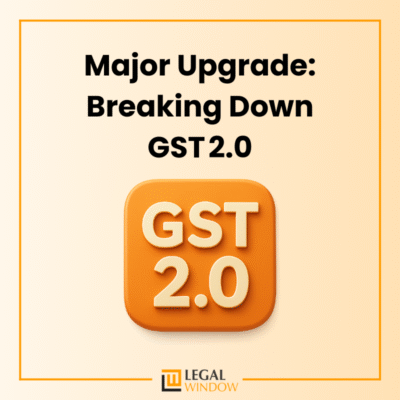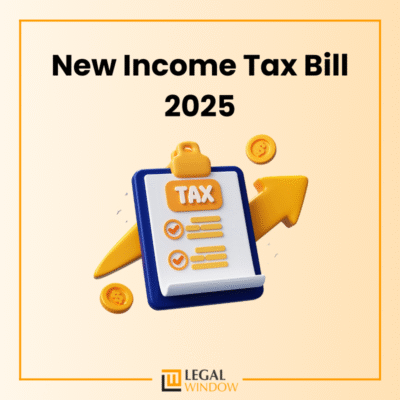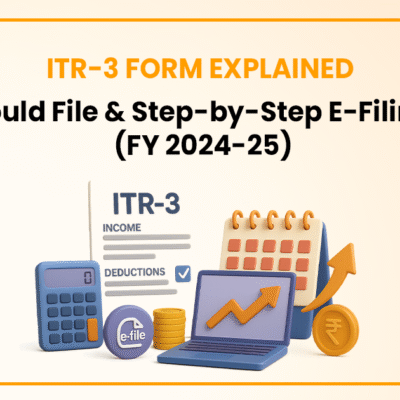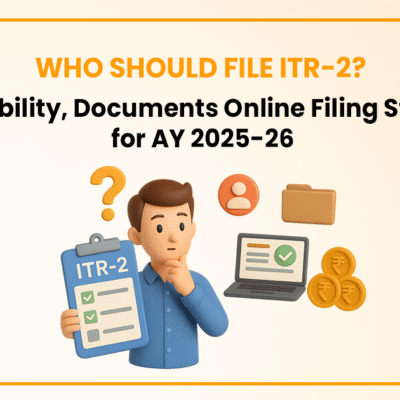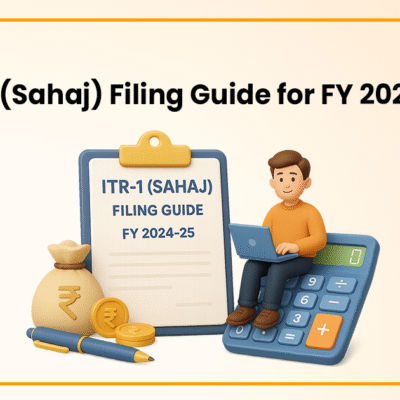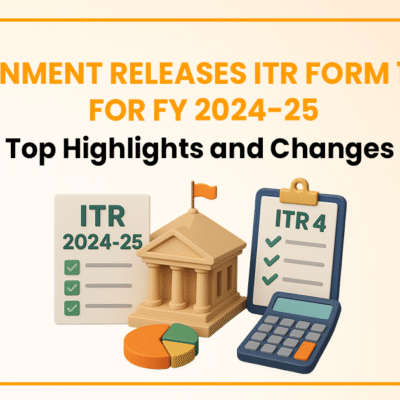Unacummulated Tax Credit on Input Services: Constitutionality of Section 54(3) of CGST Act, 2017
- August 26, 2022
- GST
 Taxation is seen as one of the necessities that influence the formation of every constitutional democracy. Tax policy decisions in India have an impact on the relationship between the government and the people. No political authority can be exerted unless certain requirements and constraints are met. The principle of taxation is unrelated to the principle of equality. Instead, equality is not a criterion for tax policy. India has a long history of having a broad and sophisticated tax code. The Indian government implemented the Goods and Services Tax (GST) in 2017 to replace the inefficient and confusing taxation structure. By prescribing multiple tax slabs, the Products and Services Tax introduced a straightforward and consistent mechanism of levying taxes on domestically produced goods and services.
Taxation is seen as one of the necessities that influence the formation of every constitutional democracy. Tax policy decisions in India have an impact on the relationship between the government and the people. No political authority can be exerted unless certain requirements and constraints are met. The principle of taxation is unrelated to the principle of equality. Instead, equality is not a criterion for tax policy. India has a long history of having a broad and sophisticated tax code. The Indian government implemented the Goods and Services Tax (GST) in 2017 to replace the inefficient and confusing taxation structure. By prescribing multiple tax slabs, the Products and Services Tax introduced a straightforward and consistent mechanism of levying taxes on domestically produced goods and services.
| Table of Content |
Short Glimpse
An important aspect of GST is the Input Credit Tax System. It is a device put in place to prevent tax cascading, sometimes known as 'tax on tax.' Prior to the implementation of the GST regime, there was no provision for a credit mechanism for the payment of Central Government taxes. In addition, there was a distinct set of taxes imposed by state governments. As a result, central government taxes were not accessible as a set-off for payment of state government taxes. The carrying forward rule superseded this form of taxation under the GST.
In other words, because the tax imposed by the federal government or the state governments is subject to the same tax regime, credit for tax paid at each level would be available as a set-off for tax paid at the next stage.
Let us first discuss the Input Tax Credit System in more detail, before we shall move on to discuss Unacummulated Tax Credit on Input Services.
Input Tax Credit Mechanism under GST
The term "Input Tax Credit" (ITC) refers to a tax that has already been paid when goods and services are purchased and is available as a tax deduction.
As an example, suppose a trader purchases an item worth 100 rs and pays 10% tax on it. And now this merchant has sold such things for Rs. 150 while collecting an Rs. 15 tax from the buyer. The dealer must now pay the government Rs. 15. Because he has previously paid Rs. 10, this Rs. 10 is the trader's ITC, and he will be accepted as a taxpayer and must pay a total of Rs. 5 in tax.
If you are covered under the CGST Act, 2017 you can use the Input Credit Mechanism. This implies that if you are a registered GST manufacturer, supplier, agent, e-commerce operator, aggregator, or any other individual listed below, you are entitled to earn input credit for your taxes on your purchases.
Section 54(3) of CGST Act, 2017
Section 54(3) of the CGST Act, 2017 states that a registered person may demand a refund of any unutilized input tax credit at the conclusion of any tax period, subject to the restrictions of sub-section (10).
Except in the following instances, no return of unutilized input tax credit will be allowed:
- Taxable supplies produced without paying tax;
- Where the credit has accrued as a result of the rate of tax on inputs being greater than the rate of tax on output supplies (other than nil rated or totally exempt supplies), save for supplies of goods or services or both as announced by the Government on the Council's recommendations: Furthermore, no reimbursement of the unutilized input tax credit would be given if the items exported from India are subject to export duty: Furthermore, no refund of the input tax credit will be permitted if the provider of goods or services, or both, requests a drawback in respect of central tax or a refund of the integrated tax paid on such deliveries.
Concept of Unutilized Tax Credit
The unutilized tax credit, also known as a cumulative input tax credit, occurs when the tax paid on inputs exceeds the output tax due. Such accumulation must be carried over to the following fiscal year until it may be used by the registered person to pay the output tax due. There might be several causes for accumulating input tax credit. Thus, Parliament has envisioned a unique circumstance in which the credit is accrued as a result of an inverted duty structure in which the tax burden on inputs seems to be greater than the output tax liability. Taking legislative notice of this scenario, Section 54(3) of the CGST Act, 2017 includes a mechanism for repayment.
Legal Provisions under the CGST, 2017
The Central Goods and Services Tax Act, 2017 was drafted in accordance with the rule-making authority granted by Section 164 of the CGST Act. Section 54 of the CGST Act allows for a tax refund. A person demanding a refund of "tax and interest, if any, paid on such tax or any other sum paid" must file an application within two years of the relevant date, according to Section 54 sub-section (1). Section 54(3) allows for a claim for a refund of unused ITC. Rule 89(5) specifies a mechanism for refunding ITC in "a scenario of a refund due to inverted duty structure." The phrase "Net ITC" is used in the calculation.
Rule 89(5) defines the term "Net ITC" as "input tax credit availed on inputs." In Rule 89(5), the term "Net ITC" originally meant "input tax credit availed on input and inputs services." The meaning of 'Net ITC' was changed on April 18, 2018, to imply that ITC is available on inputs, with prospective effect. This definition becomes applicable on June 13, 2018, with retroactive effect from July 1, 2017.
Point of Debate
Section 54(3) of the Central Goods and Services Act, 2017 allows for the repayment of Input Tax Credit when the accumulation is due to Input Tax Credit. Input Tax Credit refers to the credit of input tax paid on the delivery of goods and services. Section 54(3) does not limit the right to a refund to solely unutilized ITC that has accrued as a result of the rate of tax on inputs being greater than the rate of tax on product supplied. It also enables the return of unused ITC where the tax rate on input services is higher than the tax rate on output supply.
Though Section 54(3) of the CGST Act allows for the reimbursement of accumulated tax credits on both inputs and input services, Rule 89(5) of the CGST Rules, 2017 excludes tax on input services from the formula's scope. Section 54(3) additionally restricts tax credit refunds on the basis of two conditions: no return of unutilized input tax credit will be authorized in any scenario other than-
- Taxable supplies made without paying tax;
- Where the credit has accumulated as a result of the rate of tax on inputs being higher than the rate of tax on output supplies (other than nil rated or fully exempt supplies), except for supplies of goods or services or both as notified by the Government on the Council's recommendations.
The above-mentioned misunderstanding caused by the distinction made between input and input services to obtain a refund sparked outrage among suppliers and manufacturers. The inconsistency between Section 54(3) and Rule 89(5) resulted in a slew of High Court petitions. Assesses' principal issue was that Section 54(3) restricts a claim for reimbursement of accumulated input tax credit by limiting it to tax on inputs and would be illegal since it would result in discrimination between inputs and input services.
Judicial Pronouncement on Constitutionality of Section 54(3) read with Rule 89(5)
The Gujarat High Court held that explanation (a) to Rule 89(5), which forbids the reimbursement of "unutilized input tax" paid on "input services" as part of "input tax credit" accumulated as a result of inverted duty structure, violates Section 54(3) of the CGST Act, 2017, in the case of VKC Footsteps India Pvt. Ltd. v. Union of India. Consequently, in accordance with Section 54, it instructed the Union Government to grant the petitioners' request for a refund, taking into account the ITC on input services that were not used as part of the "Net ITC" when determining the refund under Rule 89(5). (3).
However, the Madras High Court ruled in Tvl. Transtonnelstroy Afcons Joint Venture v. Union of India that:-
- Nothing in Section 54(3) (ii) violates Article 14.
- Refund is a legal right, and it is a valid classification and use of legislative authority to limit the benefit of refund to the unutilized credit that accumulates as a result of the rate of tax on input goods being higher than the rate of tax on output supplies by excluding the unutilized input tax credit that accumulated as a result of input services.
The petitioners approached the Supreme Court because of the two high courts' inconsistent opinions mentioned above. The Supreme Court purposefully construed the legislative objective of Section 54 of the CGST Act, 2017, in the case of Union of India v. VKC Footsteps India Pvt. Ltd. The apex court considered the fundamental questions surrounding the entire case, including how to interpret the terms, input, and Net ITC, before reaching a judgment.
As a result, the Court carefully considered each party's case. According to the submissions of the Counsels, the appellant's explanation of the formula under Rule 89(5) provided to establish a legal bifurcation is legitimate. According to the assessee's arguments, the court decided that the formula should be read down and rejected since it makes a distinction between suppliers with a larger component of input goods and those with a higher component of input services.
In order to give effect to Section 54(3) (ii), which distinguishes between input goods and input services for the issuance of return, the formula in Rule 89(5) was created. The formula cannot be invalidated by just using Section 54(3) (ii) of the CGST Act once the underlying concept is preserved. Thus, by confirming the legality of section 54(3) of the Central Goods and Services Act, 2017, read with rule 89(5) of the CGST Rules, 2017, the Supreme Court upheld the Madras High Court's decision.
 Endnote
Endnote
Therefore, it may be said that the scales are always tipped in favor of those who are subject to rigorous law. Legislative requirements do not necessarily serve as restrictions on people's rights. By laying forth a plan to assist the legislature and administration in developing sound policies and frameworks, the courts consistently uphold the constitutional aim of creating laws for the social and economic benefit of the countries.
Through its qualified personnel, Legal Window offers you a high level of satisfaction and quick delivery of GST Registration certificates and other GST-related services, as well as better dealing with government requirements. For GST-related and GST compliance services, please contact our team at 072407-51000 or [email protected].
Company Secretary and diligent learner deeply immersed in the world of corporate law, compliance, and governance with a focus on developing a robust foundation in legal principles and corporate practices. Passionate about exploring the intricacies of company law, regulatory compliance, and corporate governance.
Categories
- Agreement Drafting (23)
- Annual Compliance (13)
- Change in Business (37)
- Company Law (150)
- Compliance (90)
- Digital Banking (3)
- Drug License (4)
- FEMA (17)
- Finance Company (42)
- Foreign Taxation (9)
- FSSAI License/Registration (15)
- GST (124)
- Hallmark Registration (1)
- Income Tax (214)
- Latest News (36)
- Miscellaneous (170)
- NBFC Registration (8)
- NGO (18)
- SEBI Registration (6)
- Section 8 Company (10)
- Start and manage a business (27)
- Startup/ Registration (134)
- Trademark Registration/IPR (48)
Recent Posts
- Major Upgrade: Breaking Down GST 2.0 September 15, 2025
- New Income Tax Bill 2025 August 27, 2025
- ITR-3 Form Explained: Who Should File & Step-by-Step E-Filing Guide (FY 2024-25) June 25, 2025
All Website Tags
About us
LegalWindow.in is a professional technology driven platform of multidisciplined experts like CA/CS/Lawyers spanning with an aim to provide concrete solution to individuals, start-ups and other business organisation by maximising their growth at an affordable cost.

